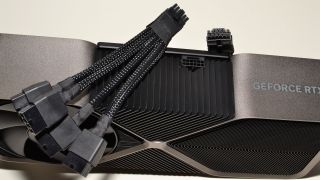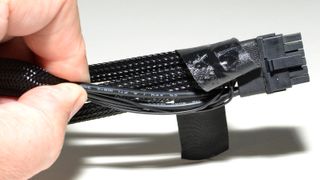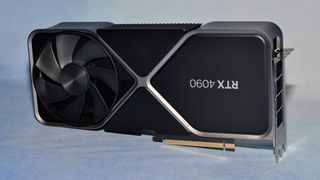Nvidia’s Melting 16-Pin Connectors on RTX 4090: All We Know
There are still more questions than answers, but reports of power problems with Nvidia’s new flagship card keep popping up.

Some Nvidia GeForce RTX 4090 graphics cards are having melting issues — meltdowns, if you will. Specifically, there have been a several reports that the 16-pin 12VHPWR adapters (used to convert multiple 8-pin PCIe power connectors to the new ATX 3.0 standard) that provide the power to the card have partially melted. In some cases, so has the 16-pin connector on the card itself.
Nvidia says that it's aware of roughly 50 instances of this issue, which it says is due to power adapters not being fully plugged into graphics cards. The company has made a point of showing "lines around the block" for the 4090, and the fact that cards are still hard to find suggests the company is selling everything it can make. In other words, while these incidents are very serious, they are be statistically rare.
Most of the melting reports are coming from anonymous users on social media, often on Reddit and other forums. These have included numerous models of the RTX 4090, including Nvidia's own RTX 4090 Founders Edition.
Here's what we know about the issues with the 16-pin 12VHPWR connector incidents so far.
What is happening?
Some RTX 4090 owners have reported that the 16-pin 12VHPWR power adapters have melted while plugged into their graphics cards (some also claim that the connectors have melted, too).
Several have written that their screens have gone black and that their fans started spinning heavily when this happened. Others have said they happened to check their connectors after reading about connector issues and found that theirs, too, had melted. Many have provided photos, but not much other information.
Several have said that they have heard from Nvidia or other card vendors after reporting their melting connector, or that they have received a replacement card.
Nvidia said that it was aware of roughly 50 cases globally. Prior to that number being released, many were relying on the r/nvidia subreddit, where members have been keeping a "List of Confirmed Cases," which counts 26 melting issues as of this writing (two of those were using ATX 3.0 PSUs and not the power adapter). An additional table of "Unconfirmed Cases" lists six more issues, which are questionable based on image quality, descriptions, or other possible damage.
Which GPUs are affected?
To date, the melting issues have occurred on a variety of RTX 4090 cards, including Nvidia GeForce RTX 4090 Founders Edition as well as cards from Asus, Galax, Gigabyte, Inno3D, MSI and Zotac.
As of this writing, we haven't heard of any similar issues with the newer Nvidia GeForce RTX 4080, which uses the same 16-pin connector. That one, however, uses three 8-pin connectors, as opposed to the four 8-pin connectors on the RTX 4090. And it has a lower power rating of 320W compared to 450W.
None of the five RTX 4090 samples that Tom's Hardware has used have shown any signs of problems with either the 16-pin adapter or connector. We do however make it a point to treat our cards with care, and that includes not plugging in and unplugging the 16-pin connector any more than necessary, as it's officially only rated for 30 cycles.
What does the 16-pin 12VHPWR adapter do?
The long-running PSU standard, ATX 2.X, can't deliver enough power over one connection to power the RTX 4090 and other high-wattage graphics cards. Indeed, there have been many cards with multiple 8-pin connectors over the last few years — various third-party RTX 3090 and 3080 family GPUs, as well as RX 6950, 6900, and 6800 XT GPUs have included three 8-pin connectors, and even four in a few rare cases.
ATX 3.0, which is slowly rolling out, is supposed to change that by delivering up to 600W over a single 16-pin 12VHPWR connector. But most people still have ATX 2.X PSUs in their systems, and ATX 3.0 PSUs are just now becoming available here and there. The adapter lets people use their existing power supplies and hook up multiple 8-pin connectors to the 16-pin connector on the RTX 4090 cards, providing enough wattage to these power-hungry GPUs.
Why are 16-pin connectors on RTX 4090 cards melting?
Nvidia has suggested that the issue is caused because 16-pin adapters are not being plugged completely into the graphics card.
Prior to that official statement, there were plenty of theories (some of which, it seems, ended up being right.)
Back in October, Igor's Lab posted that the Nvidia's adapter's "build quality… is extremely poor[,]" and that the 12VHPWR connector isn't inherently the issue. Igor's Lab also suggested that manufacturers should be crimping, rather than soldering, joints in the adapters. Gamers Nexus, however, opened one of its adapters and found it more substantially soldered than the one Igor's Lab had. Igor's Lab had 16AWG 150V rated wires in its power adapter, while Gamers Nexus had a version with 14AWG and 300V rated wires.
Gamers Nexus couldn't replicate the melting issues at first, despite mangling several adapters. It put up a poll for 4090 users where it appears less than 10% have the 16AWG 300V wires. More recently, Gamers Nexus published a video where it "successfully" caused at least one adapter to melt… by not plugging the connector in all the way and by putting strain on the cables.
In November, Jon Gerow, Corsair's PSU expert (who used to publish power supply reviews under the pseudonym JohnnyGuru) weighed in, suggesting that owners aren't fully inserting the connectors, and that a gap between the connector and the socket could be to blame. Soon after, Gerow quietly pulled the article, which he had self-published on his own site.
Stay on the Cutting Edge
Join the experts who read Tom's Hardware for the inside track on enthusiast PC tech news — and have for over 25 years. We'll send breaking news and in-depth reviews of CPUs, GPUs, AI, maker hardware and more straight to your inbox.
Initially, there were some concerns that the 12VHPWR connector could fail if the cables were bent in the wrong place. CableMod, a third-party cable manufacturer, published a "12VHPWR Cable Guide" claiming that it can't be bent near the plug, and all bends should start at least 35mm from the connector. PSU manufacturer Be quiet! places that distance at 40 mm. This is difficult to do in most PC cases. It also suggested that people need to ensure they're plugging in the cables completely.
Gabriele Gorla, director of engineering at Nvidia, told Igor's Lab that two different companies, Astron and NTK, make the adapter that ships with each RTX 4090. It's unclear if one maker is having more issues than the other.

Will a third-party cable help?
This is murky territory. In the box for the Nvidia GeForce RTX 4090 Founders Edition, the documentation reads:
"Use only the included PCIe Gen 5 compliant power connector adapter for your GeForce RTX 40-series Founders Edition graphics card. Use of non-compliant or third-party power connector adapters may cause technical issues, and may void your manufacturer warranty."
It's unclear whether third-party graphics card companies hold the same rules about warranties and third-party connectors. But Nvidia has said that any user with an issue will have an expedited RMA.
We at Tom's Hardware haven't tried any third-party cables. ATX 3.0 PSUs should work, as those cables don't require adapters for the 16-pin connector. However, there are still at least a couple of reports of direct PSU connections melting.
Some companies are already announcing new adapters for the GPU. CableMod, for instance, has a right angle adapter that it says requires less bending.
What has Nvidia said about all of this?
“We are actively investigating the reports. We are aware of about 50 cases globally," Nvidia wrote on its support site.
"Our findings to date suggest that a common issue is that connectors are not fully plugged into the graphics card. To help ensure the connector is secure we recommend plugging the power dongle into the graphics card first to ensure it's firmly and evenly plugged in, before plugging the graphics card into the motherboard.
We are investigating additional ways to ensure that the connector is secure before powering on the graphics card."
Nvidia and our partners are committed to supporting our customer and ensuring an expedited RMA process, regardless of the cable or card used.”
The company said that in testing cables returned from customers, a "wear line" can be seen, suggesting that the cable wasn't fully inserted into the connector on the card.
What has the PCI-SIG said about this?
The PCI-SIG (Peripheral Component Interconnect Special Interest Group), which is in charge of the spec for the 12VHPWR connection, sent a brief statement to the press on Dec. 1, that in short tells companies making graphics cards to conduct better safety testing. This came after a class-action lawsuit was filed in California.
"PCI-SIG wishes to impress upon all Members that manufacture, market or sell PCI-SIG technologies (including 12VHPWR connections) of the need to take all appropriate and prudent measures to ensure end user safety, including testing for the reported problem cases involving consumers as alleged in the above-referenced lawsuit," the group wrote. "Members are reminded that PCI-SIG specifications provide necessary technical information for interoperability and do not attempt to address proper design, manufacturing methods, materials, safety testing, safety tolerances or workmanship. When implementing a PCI-SIG specification, Members are responsible for the design, manufacturing, and testing, including safety testing, of their products."
What do I do if this happens to me?
If your adapter or card melts, you may see issues such as the screen going black or your fans spinning faster and louder than usual. We've seen one report where someone suggested they smelled plastic melting. If this happens, unplug your computer and check to see if there's an issue. If there is, stop using the graphics cards and contact the manufacturer. They may want you to RMA (basically return and exchange) your card.
If it hasn't happened to you, you may be fine! After all, far more RTX 4090's have been sold than reports of melting. But it may also not be a bad idea to keep an extra eye on your system. That being said, don't disconnect and reconnect your adapter more than is strictly necessary, either. Repeated stress could damage the connector and the system in other ways.

Are AMD's cards having similar issues?
AMD doesn't use 16-pin connectors–at least not yet. When it launches its next-gen GPUs, the Radeon RX 7900 XTX and 7900 XT, both will use dual 8-pin power connectors, which means that people won't have to deal with adapters at all.
What about older cards with 12-pin adapters?
Interestingly, Nvidia has used a 12-pin precursor to the PCI-SIG 16-pin connector on the Founders Edition RTX 30-series cards. To our knowledge, no one reported any melting 12-pin adapters over the past two years. RTX 3090 Ti cards also use a 16-pin connector, but they still come with a 12-pin adapter cable.
The 16-pin connector is largely the same, but it adds four extra "sense pins" that can communicate with the power supply. In our experience, the 16-pin connector does require a bit more force to fully insert. Multiple theories suggest the root cause may be improperly inserted connectors, perhaps pulled out after doing some cable management. But there is no hard proof as yet that this is the only possible cause.
Bottom Line
We do not know precisely how many RTX 4090 cards have been sold that use the 16-pin 12VHPWR connector. There are also RTX 3090 Ti and RTX 4080 cards that also use the same connector. By that token, there could be hundreds of thousands of cards with 16-pin connectors now in the hands of consumers, and only a very few of those have failed — Gamers Nexus claims the graphics card companies are saying the failure rate is between 0.05% and 0.1% right now. So about one in a thousand to one in two thousand.
If you have a card that uses a 12VHPWR connector, you're probably safe to use it. Just ensure the connector is fully inserted and that it "clicks" into place. Maybe check the connector every so often (without disconnecting it) until we learn more. And If the worst should happen, contact the manufacturer for support.
Updated November 18, 2022 following an official statement from Nvidia.
Updated December 2, 2022 following a statement from PCI-SIG.
Andrew E. Freedman is a senior editor at Tom's Hardware focusing on laptops, desktops and gaming. He also keeps up with the latest news. A lover of all things gaming and tech, his previous work has shown up in Tom's Guide, Laptop Mag, Kotaku, PCMag and Complex, among others. Follow him on Threads @FreedmanAE and Mastodon @FreedmanAE.mastodon.social.
-
-Fran- May want to update and add this as another reference now:Reply
ig2px7ofKhQView: https://www.youtube.com/watch?v=ig2px7ofKhQ
Thanks for keeping track on your own as well.
Regards. -
cyrusfox Gamer Nexus solid video, design error mingled with user error on a card that is $1600.Reply
I get it though. I don't know how many times I have drained and refilled my custom loop, go to boot the computer and forget to plug back in the power cables to the GPU. Easy to relate to those excited to take this for a spin and don't have it fully-seated + cables stretched due to cable management, card boots but is drawing too much current through too little pins leading to overheating and some smoking plastic.
The stories about poor solder joints never passed the smell test, Looking more at aesthetics than current carrying capability. -
Darkbreeze What I'd REALLY like to know is why this hasn't happened on ANY RTX 3090 ti cards that I am aware of, despite them using the exact same 12vhpwr 16 pin connector and having the exact same 450w power draw? I have a lot of respect for Steve at GN, but it would have been nice for him, or anybody, to address and explain the reasoning behind that.Reply -
Kamen Rider Blade Reply
Very few normies were able to buy RTX 3090 Ti's due to the Crypto Mining craze & GPU drought.Darkbreeze said:What I'd REALLY like to know is why this hasn't happened on ANY RTX 3090 ti cards that I am aware of, despite them using the exact same 12vhpwr 16 pin connector and having the exact same 450w power draw? I have a lot of respect for Steve at GN, but it would have been nice for him, or anybody, to address and explain the reasoning behind that.
Now, alot of normies are buying the RTX 4090. -
Darkbreeze Well, I've seen plenty of "normies" (And others) on this forum over the last six months or so with those cards in their build and can't recall any of them having this problem. Which, if it's user error, there definitely should have been.Reply -
palladin9479 ReplyDarkbreeze said:Well, I've seen plenty of "normies" (And others) on this forum over the last six months or so with those cards in their build and can't recall any of them having this problem. Which, if it's user error, there definitely should have been.
There are multiple failure modes, user inserting halfway is just one of them. It's likely a combination of multiple things happening at once, bad batch of adapters get made that pins don't quite go far enough, batch gets distributed around. Users opens box, installs card and push's cable in thinking it's all the way in, turns on computer and starts having fun. Later the failure occurs in a very unsafe way.
Stuff like this happens all the time and is resolved with the RMA process, what elevates this is the words "consumer" and "potential fire hazard", the device should of failed before getting hot enough to start that kind of damage or had some warning method to let the user know something is wrong. -
Darkbreeze Yes, I understand all that. Has nothing to do with why we haven't seen it on the RTX 3090 ti with identical 16 pin connector and identical 450w power draw though.Reply
Based on the GN deep dive it would seem that "bad batch of connectors" probably isn't a thing in this particular situation. More like, somewhat poor quality for ALL connectors, at least in terms of the low quality plating. Garbage in, garbage out.
But even that, I haven't seen any signs of from any 3090 ti owners, or heard of, at all. -
Reply
I guess that's what Jensen had in mind when he said "... We're going to survive the hard times". Reduce quality to sustain high revenue.Darkbreeze said:Yes, I understand all that. Has nothing to do with why we haven't seen it on the RTX 3090 ti with identical 16 pin connector and identical 450w power draw though.
Based on the GN deep dive it would seem that "bad batch of connectors" probably isn't a thing in this particular situation. More like, somewhat poor quality for ALL connectors, at least in terms of the low quality plating. Garbage in, garbage out.
But even that, I haven't seen any signs of from any 3090 ti owners, or heard of, at all.
Most Popular



